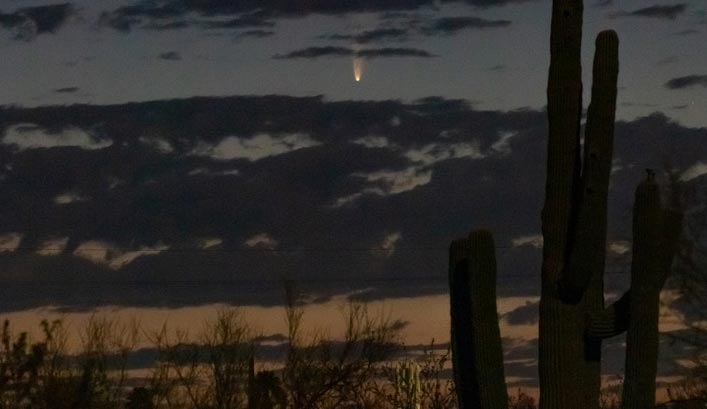Comet NEOWISE Visible in Oregon With Naked Eye
Published 07/09/2020 at 4:43 AM PDT
By OREGON TRAVEL DAILY STAFF

(Portland, Oregon) – An interstellar visitor has made a surprise visit to the skies of the U.S. and Oregon. Scientists weren’t sure that comet NEOWISE could be seen with the naked eye, but some photographers have caught photos of it in eastern Oregon already. (Photo above: the comet in Arizona taken by Vishnu Reddy)
Astronomy expert Jim Todd - with Portland’s OMSI – said the comet will still be visible for the next few days about an hour before sunrise. It will be close to the horizon in the northeastern sky, but for Oregon viewers you’ll likely have to head east of the Cascades. The other trick with this comet is that it gets lower in the sky each night.
You may get see to the comet’s central core or – or nucleus. Using binoculars will get you an even better view of the fuzzy visitor and its long, streaking tail. As it speeds away from the sun, Todd said, Comet NEOWISE will begin to make its appearance in the evening sky shortly after sunset on July 11.
NASA said the comet is shooting through Earth’s line of sight from distant parts of the solar system. Its official name is Comet C/2020 F3 NEOWISE, and it made its closest approach to the sun on July 3. As it slingshots its way back to the outer edges of the solar system it will again cross Earth’s orbit in August.
July 3 was also the day it crossed Mercury’s orbit. As it made its close flyby of the sun, that began cooking the comet's outermost layers, causing gas and dust to erupt off the icy surface and creating a large tail of debris. Even so the comet has managed to survive this intense roasting.
NASA reports it’s been seen all over the world. Astronauts aboard the International Space Station also spotted it from their vantage point in orbit over the planet.
The comet was discovered on March 27 of this year by NASA's Near-Earth Object Wide-field Infrared Survey Explorer (NEOWISE). The spacecraft used its two infrared channels, which are sensitive to the heat signatures given off by the object as the sun started to turn up the heat.
To the unmanned satellite, the comet appeared simply as red blips. Now it has a tail and a glowing interior which can be seen by humans.
According to NASA, the comet is about three miles across.
“The comet's nucleus is covered with sooty, dark particles left over from its formation near the birth of our solar system 4.6 billion years ago," said Joseph Masiero, NEOWISE deputy principal investigator at NASA's Jet Propulsion Laboratory in Southern California.
Portland
Portland Restaurants, Dining
Columbia
Gorge
Columbia Gorge Lodging
International, United States Travel, Attractions, Flight Deals
![]() Subscribe to this travel news feed in a reader
Subscribe to this travel news feed in a reader
Where to Stay on the Oregon Coast
General Oregon Coast Hotels
Seaside Hotels
Cannon Beach Hotels
Nehalem Bay Lodging
Three Capes Lodging
Lincoln City Hotels
Depoe Bay Hotels
Newport Hotels
Waldport Hotels
Yachats Hotels
Oregon Coast Vacation Rentals
Oregon Coast Lodging Specials







